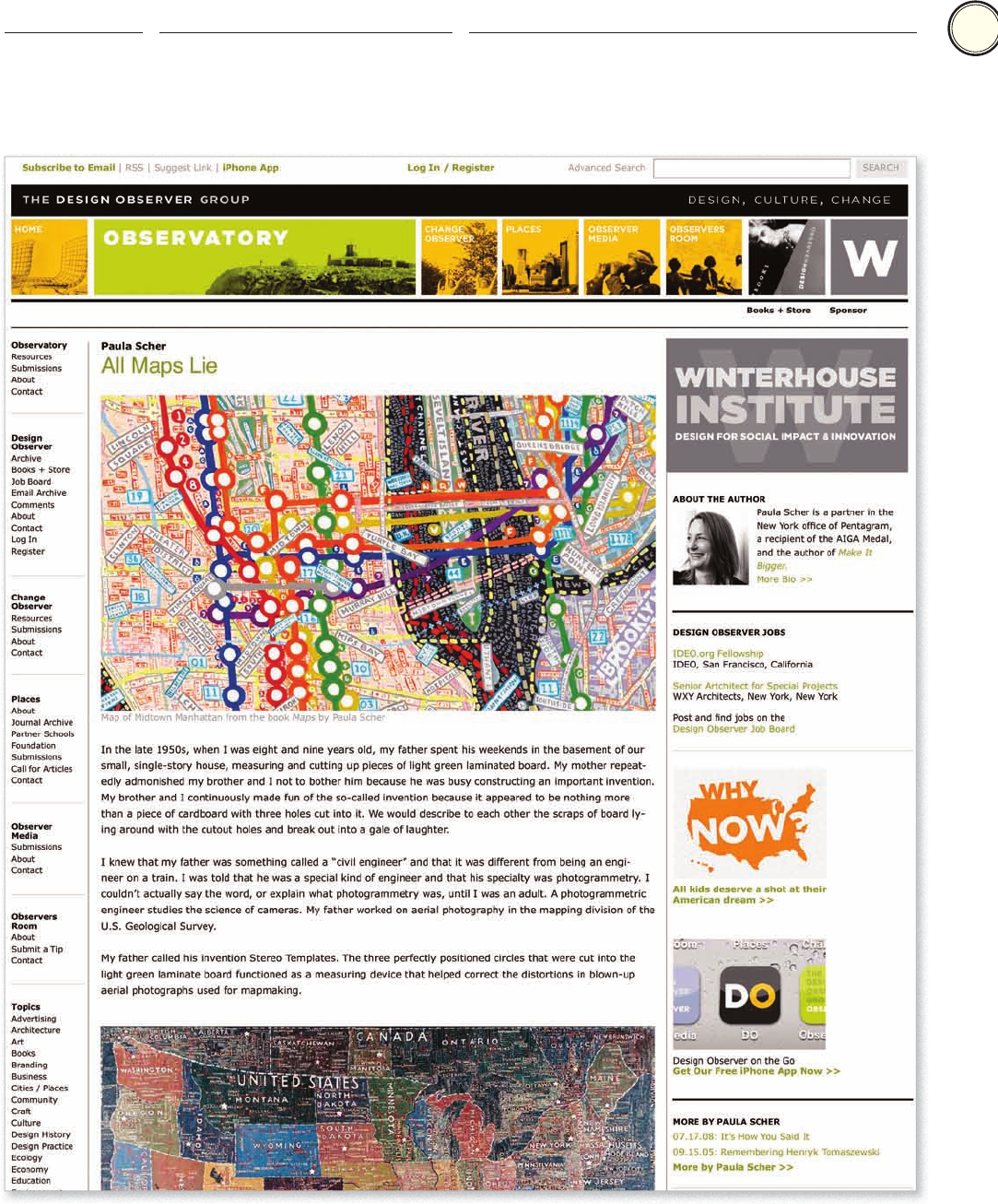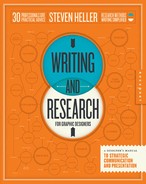
(Ray)
(Fogra 29_WF)Job:08-28858 Title:RP-Writing & Research for Graphic Designers
#175 Dtp:225 Page:26
018-055_28858.indd 26 8/30/12 4:41 PM
(Ray)
(Fogra 29_WF)Job:08-28858 Title:RP-Writing & Research for Graphic Designers
#175 Dtp:225 Page:27
018-055_28858.indd 27 8/30/12 4:41 PM
Writing & research for graphic designers
(Text)
26
Paul Rand, Herbert Bayer, Will Burtin, and Alvin Lustig,
but in some cases the logos are still extant and in others they
provide valuable case studies in success and failure. Graphic
Design: Visual Comparisons (1959), written by Alan Fletcher,
Colin Forbes, and Bob Gill during their pre-Pentagram days,
is a collection of disparate yet corresponding images that is as
inspiring for young designers now as it was for the young back
when it was published.
Who doesn’t like to read magazines? Over the past couple
of years, a few important graphic design magazines in the
United States and abroad have folded or severely reduced
their pages. A once bountiful field of design publications is
migrating to digital formats. Although a few old standbys
are still plugging away, the successful magazines cannot
resist digital pressures, and new digital outlets, such as Design
Observer (http://designobserver.com), are wellsprings of writing.
Graphic design magazines, such as Print, Communication Arts,
Eye, Idea, and Baseline, as well as academic journals including
Design Issues and Culture, are evidence of the development of
styles, propagation of standards, and canonization of the profes-
sion. Although current periodicals have come a long way since
The Second edition of Graphic Design: A History,
enabled the author to fix the mistakes and
add material that was subsequently researched.
(Ray)
(Fogra 29_WF)Job:08-28858 Title:RP-Writing & Research for Graphic Designers
09-C67944 #175 Dtp:225 Page:26
018-055_C67944.indd 26 9/22/12 11:25 AM
section 1
the three r’s : reading, writing, and research part one : reading
(Text)
27
the late nineteenth century periodicals, the common editorial
mandate to report, analyze, critique, and showcase contempo-
rary and avant-garde achievement is what makes these journals
integral to the study and practice of graphic design.
How to Read
All of us read sequentially—in the West usually from left
to right. But we also read in spurts, jumping from line to
line, paragraph to paragraph, and page to page. We are torn
between this phrase and that idea. Our media are print and
screen, with more of the latter coming into play. There are,
perhaps, too many options today. Attention is compromised
every time we click on a hotlink, or turn a printed page and
remember something we forgot or need to do. We have to
learn how to read again, especially if we want to write. We
must become reacquainted with the sublime solitude of
spending time absorbing the static page. Letters and words
need not take flight or ring-a-ding to make us take notice.
Reading is receiving information in a contemplative way.
Learning (or relearning) how to read means changing habits.
If you are a skimmer, slow down. If you are a fragmenter,
take in more. If you are a multitasker, focus on one medium
or a single text, if only for a finite time frame. If you read
in a linear, thoughtful, and absorbing way, well, then, good
for you.
Where to read is also part of this equation. Be comfortable,
but not excessively relaxed. Don’t lie in bed or on the couch,
like a slug. Sit up straight, preferably at a desk or in a chair.
Unless you are reading before bed in order to fall asleep, your
mission is to stay awake and be productive. Slow down, but
don’t drift off.
Taking Notes
One way to apply the brakes, to absorb more, and to focus
intently is to take notes. Whether they are detailed or in
shorthand, underlined or highlighted, or on sticky notes
or notepads, jotting down or making extensive notes will be
beneficial over time. (I routinely find marginalia made long
(Ray)
(Fogra 29_WF)Job:08-28858 Title:RP-Writing & Research for Graphic Designers
09-C67944 #175 Dtp:225 Page:27
018-055_C67944.indd 27 9/22/12 11:25 AM

(Ray)
(Fogra 29_WF)Job:08-28858 Title:RP-Writing & Research for Graphic Designers
#175 Dtp:225 Page:28
018-055_28858.indd 28 8/30/12 4:41 PM
(Ray)
(Fogra 29_WF)Job:08-28858 Title:RP-Writing & Research for Graphic Designers
#175 Dtp:225 Page:29
018-055_28858.indd 29 8/30/12 4:42 PM
Writing & research for graphic designers
(Text)
28
ago that prove invaluable, and congratulate myself for having
such foresight.) Note taking also puts the brakes on your
subconscious. Rather than lightly skimming over the surface,
you are forced to pay attention—and maybe even read the same
passages more than once. And don’t fret about defacing a book
or magazine. Sure, don’t write notes in priceless antiques, but
don’t feel inhibited by any other media.
Note taking is an art in itself and demands organizational
skill. One way is to jot down references in the margins or on
separate pages. This works fine but does not help you cross-
reference your notes to your readings, when you want them.
Instead, write notes on index cards or in a book or on your
iPad. Make sure you include citations that enable you to
refer to the page, paragraph, or section of what you have been
reading. If inputting notes into your laptop, you might also
tag the notes, giving them thematic keywords. You can always
introduce customized codes that only you will decipher, but
depending on your method—analog or digital—you can find
what you need quickly and efficiently. Clear and concise note
taking is an investment in time that you’ll never regret.
Reading offers two obvious rewards. First is seeing how
others write. Sampling mannerisms, styles, structural forms,
and more will allow you to test your own abilities and deter-
mine a comfortable writing technique. Second, of course, is
information. There are various ways to research and develop
content, and reading is fundamental in all of them.
Once you have established good reading habits, you are just
about ready to write on your own and, with practice, in your
own voice.
Design Observer, the most widely read of all the design blogs.
(Ray)
(Fogra 29_WF)Job:08-28858 Title:RP-Writing & Research for Graphic Designers
09-C67944 #175 Dtp:225 Page:28
018-055_C67944.indd 28 9/22/12 11:25 AM
section 1
the three r’s : reading, writing, and research part one : reading
(Text)
29
(Ray)
(Fogra 29_WF)Job:08-28858 Title:RP-Writing & Research for Graphic Designers
09-C67944 #175 Dtp:225 Page:29
018-055_C67944.indd 29 9/22/12 11:25 AM

(Ray)
(Fogra 29_WF)Job:08-28858 Title:RP-Writing & Research for Graphic Designers
#175 Dtp:225 Page:28
018-055_28858.indd 28 8/30/12 4:41 PM
(Ray)
(Fogra 29_WF)Job:08-28858 Title:RP-Writing & Research for Graphic Designers
#175 Dtp:225 Page:29
018-055_28858.indd 29 8/30/12 4:42 PM
Writing & research for graphic designers
(Text)
28
ago that prove invaluable, and congratulate myself for having
such foresight.) Note taking also puts the brakes on your
subconscious. Rather than lightly skimming over the surface,
you are forced to pay attention—and maybe even read the same
passages more than once. And don’t fret about defacing a book
or magazine. Sure, don’t write notes in priceless antiques, but
don’t feel inhibited by any other media.
Note taking is an art in itself and demands organizational
skill. One way is to jot down references in the margins or on
separate pages. This works fine but does not help you cross-
reference your notes to your readings, when you want them.
Instead, write notes on index cards or in a book or on your
iPad. Make sure you include citations that enable you to
refer to the page, paragraph, or section of what you have been
reading. If inputting notes into your laptop, you might also
tag the notes, giving them thematic keywords. You can always
introduce customized codes that only you will decipher, but
depending on your method—analog or digital—you can find
what you need quickly and efficiently. Clear and concise note
taking is an investment in time that you’ll never regret.
Reading offers two obvious rewards. First is seeing how
others write. Sampling mannerisms, styles, structural forms,
and more will allow you to test your own abilities and deter-
mine a comfortable writing technique. Second, of course, is
information. There are various ways to research and develop
content, and reading is fundamental in all of them.
Once you have established good reading habits, you are just
about ready to write on your own and, with practice, in your
own voice.
Design Observer, the most widely read of all the design blogs.
(Ray)
(Fogra 29_WF)Job:08-28858 Title:RP-Writing & Research for Graphic Designers
09-C67944 #175 Dtp:225 Page:28
018-055_C67944.indd 28 9/22/12 11:25 AM
section 1
the three r’s : reading, writing, and research part one : reading
(Text)
29
(Ray)
(Fogra 29_WF)Job:08-28858 Title:RP-Writing & Research for Graphic Designers
09-C67944 #175 Dtp:225 Page:29
018-055_C67944.indd 29 9/22/12 11:25 AM

(Ray)
(Fogra 29_WF)Job:08-28858 Title:RP-Writing & Research for Graphic Designers
#175 Dtp:225 Page:30
018-055_28858.indd 30 8/30/12 4:42 PM
(Ray)
(Fogra 29_WF)Job:08-28858 Title:RP-Writing & Research for Graphic Designers
#175 Dtp:225 Page:31
018-055_28858.indd 31 8/30/12 4:42 PM
(Text)
READING
VOICE
EDIT STRATEGY TARGET
IDEAS
(Ray)
(Fogra 29_WF)Job:08-28858 Title:RP-Writing & Research for Graphic Designers
#175 Dtp:225 Page:30
018-055_28858.indd 30 8/30/12 4:35 PM
(Text)
Getting your ideas across is a big job. Taking your
thoughts and translating them into written language
is not to be taken lightly. This section will provide
the tools you might need. But first, get in the mood.
Where you write is as important as how you write. What is the most comfortable place to be? For me
it is in a comfy office chair in front of a large screen; if it is less than 33 inches (84 cm) I feel constricted.
So find your comfort zone—whether it’s a desk with writing paper, a lap with your Mac Air, a table with
a large keyboard, or even one of those things . . . what is it called? Oh yes, a typewriter. Make sure you
are away from distractions too. No phones. No open web pages or apps. That being said, everyone has
rituals. Figure out what yours are and get them out of the way.
When I start a new essay or article, I have to walk around the room a bit before I achieve my first
paragraph. Then I have to release all the clichés I know on the page or screen. Once they are written
and then edited out, I’m ready to start. That’s when I being to really exercise my voice.
Your Voice
There is writing and then there is WRITING. Almost anyone can write a note or letter. Putting words
together that result in a comprehensible sentence is not terribly difficult once you acquire the knack.
Making those sentences fit neatly into a paragraph, however, is exponentially harder. Then from one
paragraph to a string of contiguous paragraphs that tell a story or convey a layered message, now that
is difficult. That is what many call writing.
What I call fundamental writing is in all lowercase in the previous paragraph, because it is by no
means extraordinary that a designer can successfully master this skill. Even if visual literacy is your
forte, verbal literacy—and that means transcription of thoughts and ideas through words—is essential
to being a designer. You have to know how to read and write to graduate from any school, including the
design academy.
On a scale of one to ten, just being proficient at lowercase writing is a five. This means you can write
a common letter, convey instructions, maybe even pen a proposal or brief for a particular design. To rise
above that baseline, however, you must also have a voice. By voice, I mean personality. And by personality,
I mean a quality of putting words, sentences, paragraphs, and thoughts together that are noticeably your
own—some method or manner that distinguishes what you have to say, and how you say it, from standard
or proper usage. This can be accomplished in any number of ways.
writing
Thoughts on Paper or Screen
(Ray)
(Fogra 29_WF)Job:08-28858 Title:RP-Writing & Research for Graphic Designers
#175 Dtp:225 Page:31
018-055_28858.indd 31 8/30/12 4:35 PM
..................Content has been hidden....................
You can't read the all page of ebook, please click here login for view all page.
